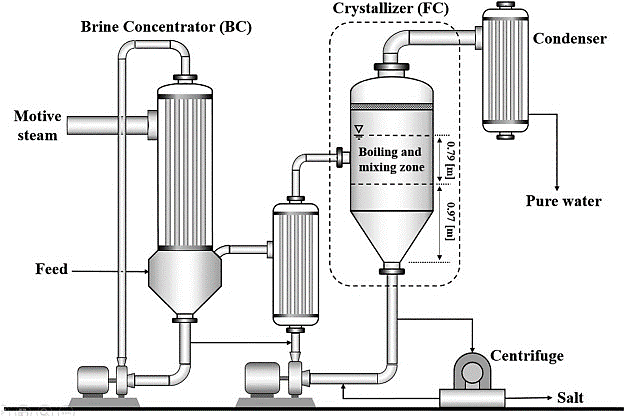
Crystallization is a physical change. Crystallization is the formation of solids from the liquid or gaseous phase. This technique includes obtaining the crystals of a soluble substance from a hot saturated solution and separating the soluble solid from the solution.
To concentrate feed into solid crystals and clean water, crystallizers are used. A progressively harder method for which crystallite sizes are formed from a liquid solution is known as crystallization. Crystallizers can remove liquid wastes completely, resulting in no liquid discharge (ZLD). The process continues and secondary crystallization are the two stages of crystallization. The formation of new crystals is referred to as primary nucleation. Secondary nucleation is the primary stage that results in the mass production of crystals. There are two types of crystallization processes: evaporative crystallization and cooling crystallization.
We hypothesize the followings for a probable system for forming the floor dense crust levels and inner pore filling crystals in the situation in the concentrated SWRO brines. Given that the salt precipitates throughout h2o evaporation, NaCl, as one of the most considerable species, precipitates dominantly while remarkably hydrous magnesium sulfate, as a minor species, precipitates only from the hole House Among the many cubic NaCl crystals. As the hydrous magnesium sulfate gradually fills the pore Room among the NaCl crystals, at one issue, a dense crust layer is formed to the surface area, which renders the evaporation substrate not able to deliver water for the outer surface area and so drinking water evaporation stops.
For that reason, right up until this issue is solved, the photo voltaic crystallizer would not accomplish to take care of actual seawater brines, although it demonstrates a wonderful performance in treating pure NaCl brines.
is processing devices utilized to rework wastewater into reliable crystals and pure h2o. Sound crystals are developed from a liquid Alternative by way of crystallization, often called a solid-liquid separation process. Liquid squander could be eradicated by crystallizers, resulting in Zero Liquid Discharge (ZLD).
On account of the rise in concentration, supersaturation of the solution happens plus the nucleation method commences. As nucleation progresses, nuclei develop and it modifications the crystals.
The entire process of crystallization is used in different applications of industries. The commercial utilization of crystallization is not really constantly obtained from pure crystals. Generally the crystallization procedure is utilized for the extensive treatment of liquid squander inside of a river or ocean.
The salt scaling brings about an almost entire loss of h2o evaporation functionality by our 3D photo voltaic crystallizer for true brines.
Using the goal of totally free control of the outer form and internal water transport channel on the evaporator, seawater evaporation crystallizers were being manufactured by 3D-printing Crystallizer Manufacturer Crystallizer For Zero Liquid Discharge System technology In this particular examine. The crystallizer structure contains two parts: (1) the very best photothermal conversion layer, which looks as if a sloping roof; and (two) The underside dice for drinking water transfer. Furthermore, the supporting buoyancy layer structure was created to provide buoyancy for your crystallizer entire body as well as the stable salt collected. The photothermal conversion part was printed with Polylactic acid (PLA)/bio carbon composite filaments. The water transfer dice was printed with pure PLA filaments.
S5a). In these conditions, if the water evaporation prices experienced dropped to Nearly zero, these crystallizer surfaces appeared pretty black, indicating the light absorption of these crystallizers wasn't drastically degraded through the precipitated salt layer (Fig. S5b, c). Thus, it is believed that the variation in the light absorption was not the actual explanation for the degraded water evaporation fees from the 3D crystallizer even though treating the actual brines.
The entire process of vacuum crystallizers is typically used being a continuous and sometimes as a collection. In business, batch vacuum crystallizers tend to be more preferred than continual vacuum crystallizers.
The salt layer when utilizing photo voltaic crystallizer to treat a pure NaCl brine, b concentrated SWRO brine and c concentrated SWRO brine with NTA.
Skip to principal articles Thank you for browsing mother nature.com. You might be employing a browser Edition with minimal aid for CSS. To get the most effective experience, we endorse you use a more up-to-date browser (or flip off compatibility mode in Internet Explorer).
On the list of significant benefits of photo voltaic pushed drinking water evaporation approach is that the water elimination price is barely somewhat influenced through the salt focus on the source h2o, and latent heat of highly concentrated NaCl brine is decrease than that of pure water38,39. Quite the opposite, the Electrical power usage and operation cost noticeably improves with the rise of salt concentration in membrane-based mostly method, especially RO40.
By structure, our 3D photo voltaic crystallizer completely physically separates its gentle absorbing area and drinking water evaporation and thus salt precipitation area, which solves The disadvantage of precipitating salt crystals impacting light-weight absorption otherwise inherent in 2nd products and allows for two surfaces for being independently optimized.
a The evaporation price (ER) of 24 wt% NaCl brine and actual seawater brines while in the 24-h Procedure; photos from the photo voltaic crystallizers once the 24-h operation utilizing b 24 wt% NaCl brine and c concentrated RO squander brine; SEM photographs with the interior aspect of QGF membrane just after operating with d 24 wt% NaCl brine and e concentrated authentic RO squander brine; file the IR photos with the photo voltaic crystallizer when treating concentrated RO waste brine.